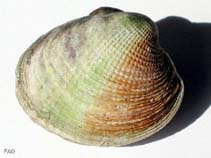Austrovenus stutchburyi (Wood, 1828)
Stutchbury's venus| Native range | All suitable habitat | Point map | Year 2050 |

|
| This map was computer-generated and has not yet been reviewed. |
| Austrovenus stutchburyi AquaMaps Data sources: GBIF OBIS |
رده بندی / Names اسامي عام | مترادف | CoL | ITIS | WoRMS
Bivalvia | Venerida | Veneridae
Environment: milieu / climate zone / تغييرات عمق / distribution range بوم شناسي
; تغييرات عمق 0 - 5 m (مرجع 101364). Temperate, preferred 14°C (مرجع 107945); 34°S - 53°S, 68°E - 175°W
Distribution كشورها | مناطق سازمان خوار و بار جهاني (FAO) | Ecosystems | ظهور | معرفي
Southwest Pacific and Antarctic Indian Ocean: New Zealand, Chatham Island and Kerguelen. Temperate to polar.
Length at first maturity / Size / Weight / سن
بلوغ: Lm ?, range 2 - ? cm Max length : 4.9 cm SHL جنس نر / بدون خواص جنسي; (مرجع 126738); بيشينه سن گزارش شده: 20 سال ها (مرجع 126742)
Life cycle and mating behavior بلوغ | تولید مثل | تخم ریزی | Eggs | Fecundity | Larvae
مآخذ اصلی
مراجع | هماهنگ كننده | همكاران
Spurgeon, A. 2007 New Zealand Mollusca. http://www.mollusca.co.nz/index.php (مرجع 8121)
وضعيت در فهرست قرمز IUCN
(مرجع 130435: Version 2025-1)
وضعيت از نظر سايتس (مرجع 108899)
CMS (مرجع 116361)
خطر برای انسان ها
استفاده انسانی
ماهي گيري – شيلات: تجاري
FAO - ماهي گيري – شيلات: landings | FishSource | Sea Around Us
ابزارها
اطلاعات بيشتر
منابع اينترنتي
BHL | BOLD Systems | CISTI | DiscoverLife | FAO(ماهي گيري – شيلات: ; publication : search) | Fishipedia | GenBank (ژنوم, نوکلئوتيد) | GloBI | Gomexsi | Google Books | Google Scholar | Google | PubMed | Tree of Life | Wikipedia (برو, جستجو) | Zoological Record



